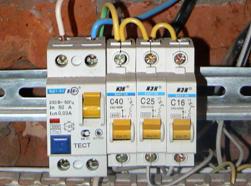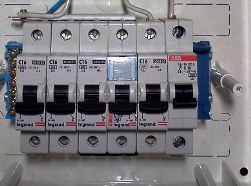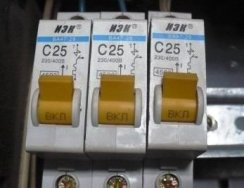Categories: Electrician at home, Automata and RCD
Number of views: 264017
Comments on the article: 27
What to do if the machine works in the electrical panel
 If the light goes out in the apartment, the sockets are turned off, or the electric stove has stopped working, then any person who is more or less familiar with electrical engineering goes to the site to check in the electrical panel circuit breaker status. Most often, troubleshooting is reduced to restarting the machine.
If the light goes out in the apartment, the sockets are turned off, or the electric stove has stopped working, then any person who is more or less familiar with electrical engineering goes to the site to check in the electrical panel circuit breaker status. Most often, troubleshooting is reduced to restarting the machine.
The fact of operation of a modern modular circuit breaker is easily determined: the handle is in the "down" position, a round sign - "zero" is clearly visible on it. To turn it on, simply turn this knob up, then a horizontal line will appear, and we can assume that the mission has been completed.
Many apartments in the post-Soviet space are equipped with guards with automatic machines of a slightly different type. AE series circuit breakers and the like have slightly larger dimensions, fasten to the base with long screws and have an unpleasant property: when triggered, their handle remains in the same upper position. This makes it difficult to find a tripped machine, which must be turned off and on again in order to re-apply voltage.
But all this, by and large, trifles. A triggered machine indicates some kind of malfunction, but we need to figure out which one.
Circuit breaker releases
First you need to find out at least in general terms, what is a circuit breaker and how does it work. Many people know that the machine breaks the "phase". A multipolar circuit breaker can also break the zero working conductor. But the machine can break the circuit not only at the request of the owner, turning the handle down. That's why it is an “automatic” switch that it can turn off automatically.
This is necessary in order to protect the conductors and apartment electrical equipment from increased electric current that can cause fire and destruction. The cause of the increase in current can be:
1. Network congestion. It can be caused by the inclusion of faulty power consumers, or power consumers, whose total power exceeds the capacity of the network. The latter may be related to improper electrical wiring around the apartment, when one group has a large number of power outlets. Each outlet separately may well not be overloaded, but their total current can reach values that are unacceptable for one machine.
For protection against overload currents in circuit breakers thermal release - a bimetallic contact, the state of which depends on the temperature, which, in turn, depends on the flowing electric current. The setpoint, that is, the trip current of the thermal release, can usually be adjusted within small limits.
2. Network short circuit. It can be caused by a fault in the wiring or the failure of any power receiver. For new wiring, a short circuit may result from an installation error, for example, when connecting wires to junction box. Physically short circuit - This is the electrical connection of the phase and neutral conductor in addition to the load. Since the circuit resistance in this case is limited only by the resistance of the wires, the electric current instantly reaches a very large value.
To protect against overcurrents of short circuit, the thermal release of the machine is ineffective: while the bimetallic contact heats up and breaks, the wires will almost certainly be damaged, and an electric arc will cause a fire. Therefore, in modular circuit breakers it is always used electromagnetic release, the response rate of which is a fraction of a second from the moment the current increases.
So, if a circuit breaker has tripped in your apartment panel, you can, of course, turn it on again. However, a systematic response indicates a problem that will have to be addressed. What to do if the machine turned off in the electrical panel?
Short circuit in the outlet circuit
 With the instantaneous operation of the machine after it is turned on, there is every reason to believe that we are dealing with a short circuit - the thermal release will not work so quickly. You can verify the presence of a circuit with multimeter - the resistance between the zero working bus N and the output of the circuit breaker during a short circuit should be close to zero. Of course, such measurements can be made only with the machine turned off.
With the instantaneous operation of the machine after it is turned on, there is every reason to believe that we are dealing with a short circuit - the thermal release will not work so quickly. You can verify the presence of a circuit with multimeter - the resistance between the zero working bus N and the output of the circuit breaker during a short circuit should be close to zero. Of course, such measurements can be made only with the machine turned off.
Once we are convinced that the cause of the operation is a short circuit, it is necessary to find out exactly where it happened. The circuit breakers in the panel must be selected in accordance with the principles of selectivity, which means that it is the circuit breaker that is closest to the location of the short circuit that must work. In this case, the switch responds only to short circuits in that part of the circuit, which is located after it relative to the line.
Therefore, let’s say, if only the input circuit breaker is tripped, then the circuit is most likely located directly in the input shield. When a circuit is closed within the apartment, a group switch is triggered and often with it an opening circuit breaker. In this case, the input device can be safely turned on again and find out which particular group of power receivers is connected to the problem wire - this group will not work.
Having clarified this issue, you can turn off all of these power consumers and re-enter the group machine into operation. If it did not work, then the cause is a malfunction of one of the disconnected electrical appliances. You can find a specific culprit either by switching on all the power consumers in turn, or by measuring their input resistance. The second method is not suitable for devices with electronic control. A defective device, of course, is subject to repair.
If all devices are serviceable, it is necessary to start inspecting the outlets that are part of the group: disassemble the plastic cases, check and tighten the terminal clamps. After sockets comes the turn of boxes. They will have to be opened. And if the inspection does not reveal obvious malfunctions, then the wires must be disconnected to check the resistance between the cores of the cables separately. Such a check will already accurately determine which cable has a short circuit. The damaged line must be replaced, and the cores in the box must be reconnected using certified clamps.
Short circuit in the lighting circuit
If the tripping circuit breaker protects the lighting circuits, the test can be started by introducing the circuit breaker with the circuit breakers turned off. The machine did not work - you can click the switches one by one in order to find out which of them has a short circuit in the circuit. Thus, we narrow the search area to the chain of a group of fixtures introduced from one switch.
In this group, each lamp should be carefully inspected by unscrewing the lamps and examining the terminal clamps. With a multimeter, you can measure the resistance between the phase and neutral wires from the side of each lamp. In this case, you can determine the lamp or cable line in which the circuit occurred.
If a short circuit is detected on all fixtures of the group, or is present in the network regardless of the position of the switch, then the location of the circuit is most likely a branch box of lighting. It must be opened and checked in the same way as in the case of the closure of the outlet network. Well, and if the box is in full order, then we call the individual cable lines, disconnecting their ends.
Network congestion
 As already mentioned, in the event of a network overload by current, the circuit breaker takes some time to operate. This is usually a few minutes. Therefore, if the machine kicks out from time to time, it may very well be that you are dealing with overload.
As already mentioned, in the event of a network overload by current, the circuit breaker takes some time to operate. This is usually a few minutes. Therefore, if the machine kicks out from time to time, it may very well be that you are dealing with overload.
Lighting circuit overload - the phenomenon is quite rare, and to avoid it, use only lamps that are suitable for the power of your lamps, and upgrade the lighting circuit taking into account the reserve for power. After all, the lighting circuits of individual apartments are often protected by one machine for ten amperes. This is often enough, but when installing a large number of additional fixtures in the shield, it is necessary to provide an additional automatic lighting for their power, especially if the lamps are halogen or with conventional incandescent lamps.
Outlet overload - this is not uncommon. During the design and installation of wiring in the house, it is impossible to accurately determine the load on each group. Therefore, for the convenience of residents, a group included by one circuit breaker has three to four outlets. And, despite the fact that the rating of the circuit breaker is usually selected according to the cross section of the supply core and does not exceed 25 amperes, the rated current of sockets can be 16 amperes.
There are all prerequisites for overloading, if all powerful power consumers, such as a kettle, iron, microwave and the like, are included in the sockets of the same group. Here, of course, the circuit breaker will trip. And to prevent this from happening, it is necessary to evenly distribute the powerful load between the groups, and in the absence of such an opportunity, not to include several powerful electrical receivers simultaneously in the network.
It happens that a faulty appliance consumes high current, which leads to network overload and the circuit breaker trips. It is not always possible to measure the current in domestic conditions, but if the thermal release is triggered only when one of the electrical receivers is turned on, and the rated power of this device does not exceed 2.5 kW, then it should be audited for malfunctions.
Circuit breaker failure
It is not so rare that the circuit breakers are constantly triggered by a malfunction of the latter. Even among new machines, a certain number of defective copies is allowed. Their inability to keep the setpoint (and this applies mainly to thermal releases) is often detected only during operation.
Therefore, with the systematic operation of the thermal release of the machine, before proceeding with radical methods of solving the problem, you can simply make a trial replacement of the machine with a similar one in nominal value and characteristic.
Finally
In the article, we deliberately ignored the moments when the operation of the machine is caused damage to the line during repair work - This is a topic for another discussion. For the same reason, we did not concern ourselves with the situation when a differential circuit breaker trips.
But in the end I would like to remind you that the most popular way to solve the problem of a triggered automaton - replacing it with an automaton of a higher nominal value - is categorically not permissible. Circuit breakers are devices that provide protection against fire and damage. Their face value is selected precisely for the purpose of ensuring safety. An arbitrarily selected machine will not perform its functions and will not protect against dangerous operating modes of the electrical network.
Alexander Molokov
See also on this topic: Is it worth replacing a circuit breaker if it "knocks out"?
See also at e.imadeself.com
:
